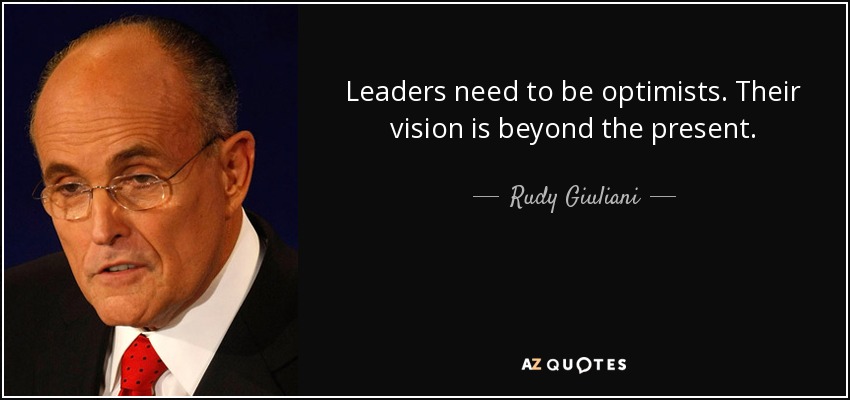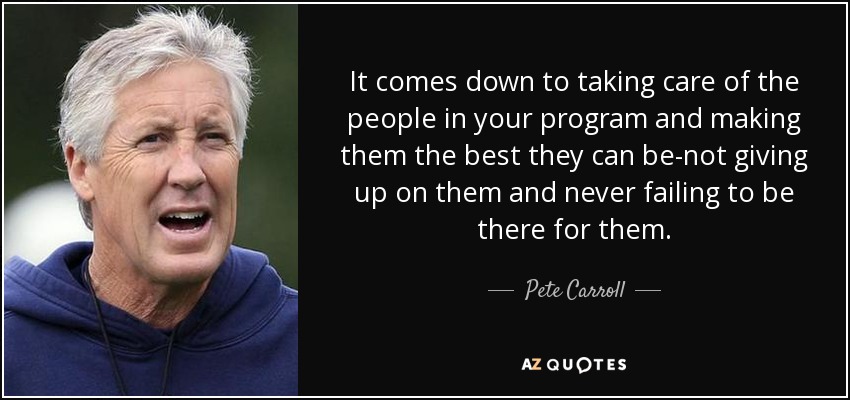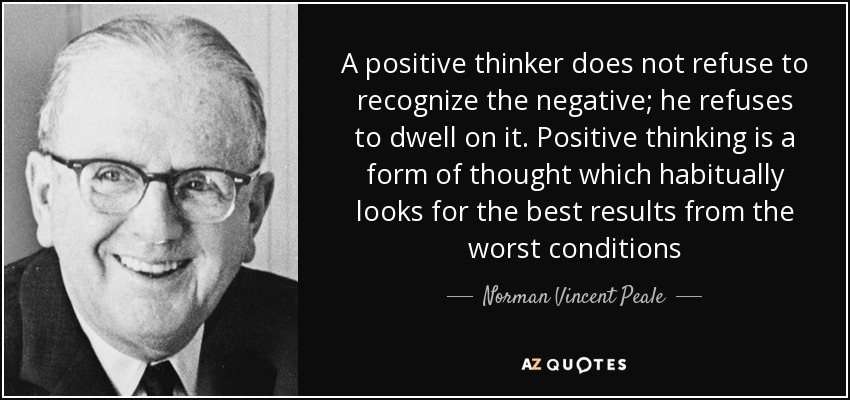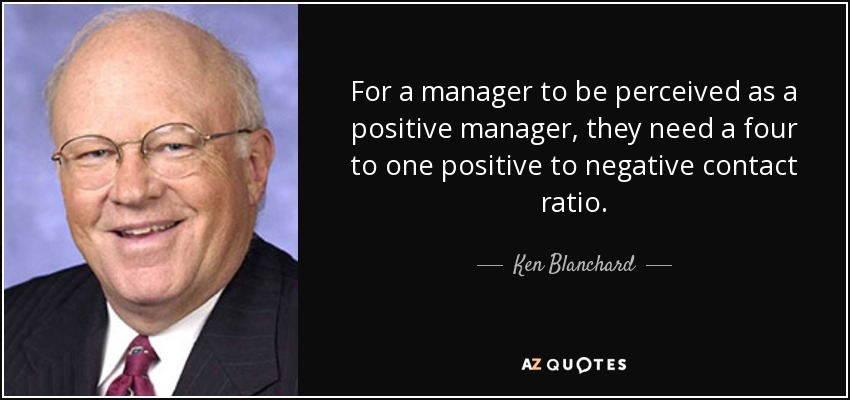Click here to return to Blog Post Intro

Real Positive
When some people hear the term positive leadership they roll their eyes because they think of Pollyanna positivity, where life is full of unicorns and rainbows. But the truth is that we are not positive because life is easy. We are positive because life can be hard. Positive leadership is not about fake positivity. It is the real stuff that makes great leaders great.
Throughout history we see that it’s the optimists, the believers, the dreamers, the doers, and the positive leaders who change the world. The future belongs to those who believe in it and have the belief, resilience, positivity, and optimism to overcome all the challenges in order to create it.
Psychologist Barbara Fredrickson’s research revealed that people who experience more positive emotions than negative ones are more likely to see the bigger picture, build relationships, and thrive in their work and career, whereas people who experience mostly negative emotions are more likely to have a narrower perspective and tend to focus more on problems.
Daniel Goleman’s research demonstrated that positive teams perform at higher levels than negative teams. Research also shows that workgroups with positive-to-negative interaction ratios greater than three to one are significantly more productive than teams that do not reach this ratio.
Positive leaders invest their time and energy in driving a positive culture. They create and share the vision for the road ahead. They lead with optimism and belief and address and transform the negativity that too often sabotages teams and organizations.
Positive Leaders Drive Positive Cultures
Your most important job as a leader is to drive the culture—and not just any culture. You must create a positive culture that:
- energizes and encourages people,
- fosters connected relationships and great teamwork,
- empowers and enables people to learn and grow, and
- provides an opportunity for people to do their best work.
Culture is not just one thing; it’s everything. Culture drives expectation and beliefs. Expectations and beliefs drive behaviors. Behaviors drive habits. And habits create the future. Culture not only beats strategy, but it also fuels it and drives people and organizations to record growth and performance.
You might be wondering where to start when driving and building a culture. Start with these two questions:
- What do we stand for?
- What do we want to be known for?
When your culture dictates your decisions, you are on the right path to positive results.
Driving a positive, high-performing culture requires more than words. After all, everyone has a mission statement, but only the great organizations also have people who are on a mission. It doesn’t matter what core values you have written on the walls of your building and website if you don’t live and breathe them every day. Remember Enron? One of their core values was integrity. As a positive leader, you can’t just show the way and talk about the way. You must also lead the way. You must live your culture.
Education expert Todd Whitaker says that the unwritten rules in an organization are more important than the written ones. The rules you set with your example are what your organization is really all about, so make sure you live and breathe the values written on the walls.
Your team is just as likely to catch your bad mood as the flu and, on the flip side, they will catch your good mood as well. As a leader your attitude, energy, and leadership is contagious, and it has a big impact on your culture. Are you going to be a germ to your team or a big dose of vitamin C?
Positive leaders don’t live in a Pollyanna world. They understand that every day there are forces seeking to sabotage their culture and success, and so they work relentlessly to keep it strong.
Positive Leaders Create and Share a Positive Vision
As Alan Mulally, former President and CEO of Ford Motor Company put it, “Positive leadership—conveying the idea that there is always a way forward—is so important because that is what you are here for—to figure out how to move the organization forward.”
Positive leadership is all about seeing and creating a brighter and better future. A positive leader sees what’s possible and then takes the next steps to rally and unite people to create it. In order to rally people to follow you, you must be able to articulate and communicate your vision in a simple, clear, bold, and compelling way.
The vision a positive leader creates and shares serves as a North Star that points and moves everyone in an organization in the right direction. As a positive leader you will want to carry a telescope and a microscope with you on your journey. The telescope helps you and your team keep your eyes on your vision, North Star, and big picture. The microscope helps you zoom-focus on the things you must do in the short term to realize the vision in your telescope.
When the people on your team identify what the vision means to them, ask them what their personal vision is and how it can help contribute to the bigger vision of the organization. Then ask them how you can help them on their journey. What do they need from you to be their best?
When people know how they are contributing to a bigger vision and have a bigger purpose at work—and feel like their manager-leader-coach genuinely cares about them—the research shows that engagement soars.
Positive Leaders Lead with Optimism, Positivity, and Belief
The fact is, if you don’t have optimism and belief, you can’t share it. If you don’t have it, you can’t transform your team and organization with it. It starts first and foremost with you. Before you look at anyone else on your team and in your organization, look in the mirror and ask yourself: Are you a positive leader? Do you believe? Are you optimistic?
Dr. James Gills accomplished the remarkable feat of completing a double triathlon (two triathlons back to back with only a 24-hour break). Even more remarkable is that Gills completed a double triathlon six times, and the last time he did it he was 59 years old. When asked how he did it, he gave the best advice. He said, “I’ve learned to talk to myself instead of listen to myself.” He memorized scripture and would recite it to himself when he needed a boost. Gills continued, “If I listen to myself, I hear all the reasons why I should give up. I hear that I’m too tired, too old, too weak to make it. But if I talk to myself, I can give myself the encouragement and words I need to hear to keep running and finish the race.”
In the words of Babe Ruth, “Every strike brings me closer to the next home run.” It’s the same way with life. Anyone pursuing anything worthwhile will fail and fail often. The story we tell ourselves determines the life we live.
The Gallup Organization did a study where they asked people to name the best and worst event of their lives. They found that there was an 80 percent correlation between the two events. Somehow the worst event of our lives often leads to the best, if we stay positive, stay the course, and keep moving forward.
Erwin McManus said, “Greatness is never born from easy circumstances. We can become stronger when the world becomes harder.”
Remember that it’s never about the circumstance. It’s not the challenge, change, economy, election, adversity, or setback you are facing. It’s always your state of mind and your thinking that produces how you feel and respond.
Pete Carroll, the head coach of the Seattle Seahawks, is well known for his positive leadership style. Carroll said, “The world trains people to be pessimistic. One of the most important things I must do here is make sure my players and staff believe that tomorrow will be better than today.” In essence, Pete is saying that he must transfer his belief and optimism to his team.
Every business and leader, wherever they are located, can create a bubble of optimism and transfer their belief to their team, tribe, organization, community, city, and following. There is always a new idea or a better way of doing something waiting for someone to implement it. It can be you!
Great teams are collectively positive. They have a collective belief and contagious optimism—and it starts with you. When you believe, you can inspire others to believe. Share your optimism, belief, and faith with your team. Show them the way forward. On your leadership journey, it will take all your optimism, belief, and positivity to help others become all that they are meant to be.
Positive Leaders Confront, Transform, and Remove Negativity
Being positive won’t guarantee you’ll succeed but being negative will guarantee you won’t.
Not everyone will have the same vision as you. Not everyone will believe in your dreams. Not everyone will get on your bus. But to succeed, your positive energy must be greater than all the negativity. Gandhi said, “I will not let anyone walk through my mind with their dirty feet,” and neither should you.
The first rule of thumb when weeding the negative is to not let it bring you down. Be more positive than the negativity you face. To effectively deal with an energy vampire on your team is not to remove but to transform. No one really wants to be an energy vampire. These people are likely negative for a reason. The first steps should always be to listen with empathy and love, and try to understand and transform.
When you feed the positive and create a culture where energy vampires are uncomfortable being negative, they will either change or walk off the bus themselves. Your job as a leader is to create an environment where your people can do their best work without being affected by an energy vampire. You have to feed and weed, weed and feed.
As a leader, consider instituting the “No Complaining Rule.” The no-complaining rule is simple: You are not allowed to complain unless you also offer one or two possible solutions. Every complaint represents an opportunity to turn something negative into a positive. We can utilize customer complaints to improve our service. Employee complaints can serve as catalysts for innovation and new processes. Our own complaints can serve as signals that let us know what we don’t want so we can focus on what we do want. And most importantly, we can use the no complaining rule to develop a positive culture at work.
Positive teams work together more effectively. They stay positive, connected, and committed through challenges. They maximize each other’s talent. They believe together and achieve more together. Positive, high-performing teams don’t happen by accident. They are built by positive leaders and team members who weed the negative and feed the positive.
Positive Leaders Create United and Connected Teams
It’s the leader’s ability to unite and connect people that truly creates great teams and organizations.
A lack of connection between leaders and their team leads to a lack of commitment, below-average teamwork, and sub-par performance and results. You can be the smartest person in the room but if you fail to connect with others you will fail as a leader. When you make time to connect with your team and create unity by bringing people together, performance will rise to create a united and connected organization.
As a positive leader, you must be a unifier and connector who fosters relationships between others. To help team members become more connected, have each person share a defining moment in their life. When you learn someone’s defining moment, you get to know them a whole lot better and develop a stronger connection with them. You could also have each person on the team share their hero, hardship, and highlight.
Research shows when we are busy and stressed, we activate the reptilian part of our brain, which is associated with fear and survival. Reptiles are incapable of love because they are all about survival. Research also shows you can’t be stressed and thankful at the same time.
When you know unity is the key and busyness and stress are the enemies, you will slow down and make the time to develop and build great relationships.
Positive Leaders Build Great Relationships and Teams
People follow the leader first and their vision second. What you say is important, but who you are is even more important. The two questions that the people you lead are asking are, “Can I trust you?” and “Do you care about me?” To be someone who people want to follow, you have to be someone they can trust—someone who cares about the people you lead.
Leadership begins with love. Bob Goff, the author of Love Does, says that love is not a noun. It’s a verb. It’s about leading with and sharing love. Goff is the founder of Love Does, a nonprofit that fights the injustices committed against children. Goff has spent years working to rescue underage girls from the bondage of sexual slavery.
If you want to build a great team, business, family, school, or organization, love the people you lead and work with. In education, research shows that when principals have a relationship with their teachers, engagement rises; when students have a relationship with their teachers, test scores go up.
In a world where we have more ways to communicate, we are communicating less meaningfully and our relationships, teamwork, and overall engagement and performance are suffering. Where there is a void in communication, negativity will fill it. Without great communication, negativity fills the void and it breeds and grows, resulting in negative contagious energy that quickly spreads. This is why communication is also essential. It not only develops great relationships and trust, but it also prevents the spread of rumors and negative energy that can sabotage a team and organization.
As a leader you can’t just speak to other leaders who have the same vantage point as you. You have to engage people who are closest to the potential challenges facing your organization. You have to ask questions, listen, and learn, and then decide how to use the readings to make decisions going forward.
People often think of communication as talking, but it’s also about listening. The best communicator is not always the most eloquent speaker, but rather the person who has the ability to listen, process the information, and use it to make decisions that are in the best interest of the team and organization.
As a positive communicator, you have the power to make someone feel better just by smiling. No matter what your job is, when you smile at someone, remember you are acting as a pharmacist giving them an antidepressant. Positive leaders and communicators rely on nonverbal communication. They encourage through nods, facial expressions high-fives, handshakes, pats on the back, fist bumps, and even hugs when appropriate. Positive communication isn’t just verbal. It’s also physical.
Truett Cathy, the founder of Chick-Fil-A, asked rhetorically, “How do you know if a man or woman needs encouragement?” His response: “If they are breathing.” Fuel your team with your positive energy. Rally others to focus on what is possible rather than what seems impossible. Share encouragement. Positive leaders do more than just communicate, they connect heart to heart.
Maya Angelou said, “A leader sees greatness in other people. He nor she can’t be much of a leader if all she sees is herself.” Positive leaders see others and commit to bringing out the greatness of others. It all comes down to caring. If you don’t love, you don’t care, and if you don’t care, you won’t make the time to unite, communicate, encourage, connect, commit, serve, or sacrifice. Positive leaders care about the people they lead. They care about their team and organization.
Pat Summitt, the legendary women’s basketball coach at Tennessee, said, “I won 1,098 games and eight national championships, and coached in four different decades. But what I see are not the numbers. I see their faces.” And her players still talk about how she cared about the faces she saw. A caring leader unites, connects, encourages, and transforms teams and organizations and changes the world.
Positive Leaders Pursue Excellence
People think you have to choose between positivity and winning. You don’t have to choose. Positivity leads to winning.
Positive leaders make their life and work a quest for excellence. When they wake up, they ask themselves, “How can I get better to make the world better?” Positive leaders are humble and hungry. They don’t think they know it all. They are life-long learners who are always seeking ways to learn, improve, and grow. They are always open to new ideas and strategies to take their life and work to the next level. They live with humility, knowing that the minute they think they’ve arrived at the door of greatness is the moment it will get slammed in their face.
Positive leaders who are able to create amazing teams and results provide both a lot of love and a lot of accountability. If your team knows you love them, they will allow you to challenge and push them. Instead of tough love, it needs to be love tough.
Practice the “One Percent Rule,” a simple rule Gordon shares with leaders and teams to help them create excellence. The rule says to give one percent more time, energy, effort, focus, and care today than you gave yesterday.
Through love and accountability, clarity and action, and a relentless drive to improve and succeed, positive leaders transform their quest for excellence into a better future for all.
Positive Leaders Lead with Purpose
Hard work doesn’t make us tired. A lack of purpose is what makes us tired. We don’t get burned out because of what do. We get burned out because we forget why we do it. As a leader you need to know, remember, and live your why and inspire the people on your team in your organization to do the same.
Research shows that people are most energized when they are using their strengths for a bigger purpose beyond themselves. Leaders should share their vision and purpose in one statement.
The truth is that numbers and goals don’t drive people. People with a purpose drive the numbers and achieve goals. Research clearly shows that true motivation is driven by meaning and purpose rather than extrinsic rewards, numbers, and goals. A study of West Point alums showed that those who had intrinsic goals, “I want to serve my country and make a difference” outperformed those with extrinsic goals “I want to rise in the ranks and become an officer because it’s prestigious.”
A powerful and practical way to live with purpose throughout the year is to pick a word for the year that will inspire you to live with more meaning and mission, passion and purpose.
Researchers conducted a study and they asked a group of 95-year-olds if they could live their lives over again, what they would do differently. The three things that almost all of them said were:
- They would reflect more. They would enjoy more moments, more sunrises, more sunsets, more moments of joy.
- They would have taken more risks and chances. Life is too short not to go for it.
- They would have left a legacy, something that would have lived on after they die.
Positive Leaders Have Grit
Angela Duckworth’s research at the University of Pennsylvania identifies grit as the number-one predictor and factor of success. It’s not talent, title, wealth, or good looks. It’s grit, the ability to work hard for a long period of time towards a goal; to persevere, overcome, and keep moving forward in the face of adversity, failure, rejection, and obstacles.
Grit keeps you moving forward through the sting of rejection, pain of failure, and struggle with adversity. When life knocks you down, you may want to stay down and give up, but grit won’t let you quit.
If you don’t love it, you’ll never be great at it. If you don’t love it, you won’t work to overcome all the challenges to keep doing it. If you love what you do, you won’t quit when the world says you should.
Love powers grit, and it also powers you over fear. Love is the antidote to fear. Love casts out fear so where there is love, fear dissipates.
Many people think that the more success you have, the less fear you have but, actually, it often works the other way. The more success you have, the more fear you have because you have more to lose and further to fall. There would be no stories of positive leaders changing the world if they didn’t have to overcome adversity and failure in order to do so. So the next time you fail, remember that George Washington lost two-thirds of all the battles he fought but won the Revolutionary War. Abraham Lincoln suffered nine election defeats, the death of a spouse, a nervous breakdown, and two bankruptcies before becoming President of the United States.
Remember, there was even once a leader who transformed the world by feeding the hungry, healing the sick, and loving the unlovable, and yet he was killed for it.
Lead the Way Forward
Keep in mind that the best is yet to come. Yes, there’s a lot of negativity in the world. Yes, there are many problems that haven’t been solved yet. But instead of focusing on all that’s wrong, you can realize that this is your time to make things right. With all the negativity in the world, what a great opportunity you have to be a positive leader and influencer.




